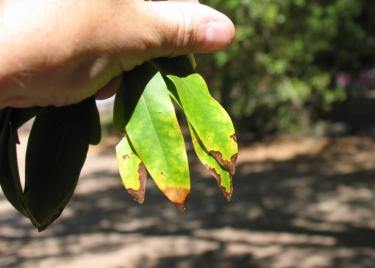Your Checklist for Prevention
You can keep your woods safe by keeping out the fungus that causes sudden oak death, Phytophthora ramorum.
Sanitation. Anyone who has been to an infected area should clean mud, dirt, and plant material off their shoes and vehicles before going to another place with susceptible plants. Also clean hands and tools thoroughly.
Inspect nursery plants. Before you buy plants of a host species, inspect them carefully. Point out any possible signs of infection to nursery employees. The infection isn't always visible, so if you bought a plant in an area with infection, you may want to quarantine it in a pot for 8 weeks in a damp part of your land to see if signs of sudden oak death appear.
Keep oak trees healthy. Phytophthora ramorum attacks both healthy and stressed trees, so keeping your oak trees healthy won't completely protect them from this disease, but it may help. Talk to a forester about whether you should be thinning your trees.
Fungicide. Treatment with a phosphonate fungicide approved for use against sudden oak death can save individual trees in an area with active infection, if it's applied to those trees before they get infected.
Remove laurels. If you're in an area of current infection or where infection is expected to reach soon, you may want to consider removing California bay laurels to protect nearby healthy oaks or tanoaks. This isn't practical if you have a large number of California bay laurels. Bay laurel is extremely infectious, so don't take the material anywhere else. You can burn it or chip it, although you then have to disinfect the chipper.
Remove dead oaks and tanoaks. Cut up the logs and spread them in a sunny place to dry them rapidly. This kills the fungus so it can't attack healthy trees.
Whether you’re trying to prevent an infection or controlling damage from an existing infection, you don’t have to go it alone. State, county or consulting foresters, the Forest Service or your local cooperative extension service can all help you protect your woods and preserve your forest legacy.
Useful link: http://www.suddenoakdeath.org/
How can I get more tips?
It’s simple! Enter your email below.

